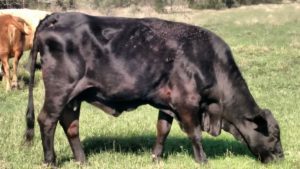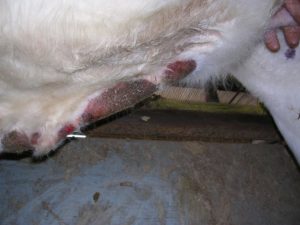Horn flies can damage cattle skin, need to be controlled
Writer: Dr. Joe Paschal, 361-265-9203, [email protected]

The other day when I was turning out the cows to a rested pasture full of green grass and winter weeds, I noticed many of them had several horn flies and other cows had quite a few. I guess it is going to be an early season.
The horn fly, which seems to be a misnomer since they congregate on cattle without horns, too, were introduced to the U.S. from Europe in the late 1800s. They were called horn fly because they clustered at the base of the horns on cattle. However, they now congregate almost everywhere on the cow’s body. They are the same color as a house fly but much smaller – about 3/16 of an inch in length.
The horn fly lays its eggs in a freshly dropped cow manure pad where they hatch in about 24 hours. The manure needs to be less than an hour old because the female fly must deposit eggs inside the manure before the surface hardens.
The eggs hatch into larvae or maggots and after 4-5 days pupate for a week to 10 days before emerging from the pad. Within 2-3 hours after emerging, they can be feeding on cattle, where they can take 30-40 meals per day.
The females can mate within two days after emerging and lay several hundred eggs a day later and for several days afterward. The entire life cycle takes 12-14 days in the summer. Horn flies appear on the first warm days of spring and are active until the fall and cool weather. They prefer warm, humid days.

Horn flies puncture the skin to suck blood and usually are found on parts of the cow’s body not easily reached by the head or tail. Horn fly bites can cause extensive hide damage.
When temperatures are high, they move to the shaded parts of the belly. Unlike most flies, they remain on the animal day and night. Large numbers of horn flies cause constant irritation and can cause loss of condition, weight and milk production.
Research has shown a 15-20 perent reduction in weight and gain when horn fly populations are excessive – more than 250 flies per head. They can also transmit several diseases including Stephanofilariasis, a condition caused by a small filarial parasite that migrates to the dorsal midline of cattle in the fall in the South. This migration causes the cattle to scratch and scrape themselves until they bleed to relieve the pain. That’s what causes the large scars on the navels of many commercial cows. It also damages their hides – and value, especially in purebred cattle – as well.
There are several management practices and numerous products and methods of application to help control horn flies. Management practices include pasture rotation that helps break the life cycle and dragging small pastures and traps to break up manure pads.
There are biological control methods including mites, beetles and wasps that feed on the larvae as well as dung beetles, which help break up manure pads.
Insect growth regulator in mineral or other feeds inhibit the larvae’s development into adult flies. Pesticide control methods include a variety of chemicals that are either self-treatment or applied as sprays, pour-ons, dips, ear tags, dust, back rubs, insecticide balls and in dust bags. Each product and application have pluses and minuses, but a combination of management and chemical control yields the best results if not complete control. I use a combination of pasture rotation, ear tags, and a back rubber but I have used IGR in past.
Dr. Sonja Swigert, our Extension Veterinary Entomologist, has rewritten a bulletin titled “Managing External Parasites of Cattle” that not only discusses horn flies but other external parasites and their control. Her publication on “Protecting Cattle from Horn Flies” is also available. If you would like copies, contact your local County Extension Agent or myself or access them at bit.ly/2DP1YuV and bit.ly/2IPg4A9.
Joe C. Paschal is a livestock specialist with the Texas A&M AgriLife Extension Service in Corpus Christi. Contact him at [email protected] or 361-265-9203.
-30-
via source the Victoria Advocate | Horn flies can damage cattle skin, need to be controlled